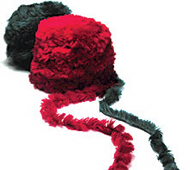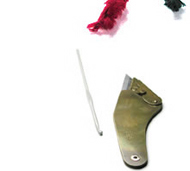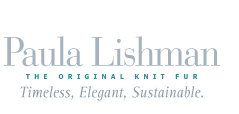| Knit
Fur
 Every garment manufactured at Paula Lishman International
is fabricated by experienced artisans using Paula’s exclusive
methods to create fur yarn and turn it into designs of the
highest quality. The Lishman
collection includes full-length coats, strollers, jackets,
shawls, blankets, and accessories. Sheared beaver is the fur
of choice for most of Paula's knits due to its silky softness.
Furs
such as mink, ranched fox, red fox, muskrat, and raccoon supplement
as trims. Each piece has luxurious fur inside
and out. The Paula Lishman look combines elegance
and flair with functionality.
Every garment manufactured at Paula Lishman International
is fabricated by experienced artisans using Paula’s exclusive
methods to create fur yarn and turn it into designs of the
highest quality. The Lishman
collection includes full-length coats, strollers, jackets,
shawls, blankets, and accessories. Sheared beaver is the fur
of choice for most of Paula's knits due to its silky softness.
Furs
such as mink, ranched fox, red fox, muskrat, and raccoon supplement
as trims. Each piece has luxurious fur inside
and out. The Paula Lishman look combines elegance
and flair with functionality.
Purchasing, Pelts and Processing

The trapping of wild animals is beneficial to the future of our
wildlife because it maintains a balance between the animal
populations and their habitat, ensuring enough resources for
the species to thrive in future generations. The fur trade
enables many Canadian families to preserve their traditional
lifestyles and culture, earning a living in harmony with the
land.
Less
than 20% of all beaver pelts available meet Lishman's criteria.
The company must buy only the pelts gathered at the optimum time of the year,
to ensure prime mature pelts with dense, heavy fur. The size and condition of
the pelt determine the quality of the fur, only the top quality pelts are
suitable for use in the knit fur process.
Pelts are purchased from several sources. Beaver, muskrat,
red fox, and raccoon are wild furs and they are sorted by
trappers, country collectors, and brokers. The mink and fox
Paula uses are farm-raised and they are purchased dressed
from various suppliers.
These carefully selected pelts are shipped to a fur dresser
where they are processed through several stages of preparation
such as soaking, sweating, plucking, and cleaning. As much
of this is done by hand, this process can take up to four
weeks.
The pelts are returned to Lishmans for further grading to
ensure that, once again, only the best fur is used. The dressed
pelts are forwarded to a fur dyer where they are graded for
colour and quality, and once dyed, are returned to our production
house. Although the company buys only the best fur, with all
of these quality measures in place, 25% to 35% of the fur
is still unusable for Paula Lishman garments.
Nature of Fur and Nature of Knit
 Because
fur is a natural product, no two pelts are the same. Each
is unique and varies in thickness of skin, fur density, natural
colour, and size. All of these factors affect the dying, grading,
and production processes. It is important to note that maintaining
consistency within styles and garments is difficult, and there
will always be minor variances in the thickness and colour
of the fur. The variances in thickness of the skin can also
affect the tension of the knit and the weight of the garment,
thereby affecting the size and measurement. Because
fur is a natural product, no two pelts are the same. Each
is unique and varies in thickness of skin, fur density, natural
colour, and size. All of these factors affect the dying, grading,
and production processes. It is important to note that maintaining
consistency within styles and garments is difficult, and there
will always be minor variances in the thickness and colour
of the fur. The variances in thickness of the skin can also
affect the tension of the knit and the weight of the garment,
thereby affecting the size and measurement.
Fabrication of Fur Yarn
Each pelt is cased, then hand blocked - the backing
dyed to match the colour of fur. This is a necessary process
for knit furs and is not required in traditional fur garments.
The pelts are dried for 18 hours. Any unusable fur (scars,
guard hairs not removed in dressing) is removed. Pelts are
hand cut into one continuous strip by trained cutters. This
process is unique to Paula Lishman International, producing
a strong fur yarn with very few sewing joins. This increases
the durability and smooth surface of the fabric. The strips
of fur are then transformed into fur yarn, using Paula's unique
process patented in 1979.
Development and Design
 After
the initial research and development of new fur fabric swatches
and style trends, ideas are sketched and pattern drafting
begins. The first pattern in this process is on paper, from
which a canvas is cut. Once the design is approved to be included
in the line, a written knitting pattern is translated from
the paper shape. For each style, for each style detailed instructions
are followed by the knitting, assembly, pelting, and finishing
departments to ensure garments meet the required specifications. After
the initial research and development of new fur fabric swatches
and style trends, ideas are sketched and pattern drafting
begins. The first pattern in this process is on paper, from
which a canvas is cut. Once the design is approved to be included
in the line, a written knitting pattern is translated from
the paper shape. For each style, for each style detailed instructions
are followed by the knitting, assembly, pelting, and finishing
departments to ensure garments meet the required specifications.
Handmade in Canada

Each garment at Paula Lishman International passes through
many hands before it is delivered to the customer.
Within each stage of production, there are quality control
measures in place starting with the fur yarn.
Order information is forwarded to our “Lotting”
department where the material required for the garment is
selected, paying close attention to the specific dye lot and
grade of fur. The materials are forwarded to one of our home-based
skilled knitters. After knitting the pieces, these are inspected
for quality workmanship, washed, blocked, air-dried for 12
hours and cleaned in one of our custom made drums.
The next step in production is assembly, where the pieces
are skillfully hand stitched into a garment and inspected
once again for quality of workmanship. The garment is then
sent for final cleaning and glazing and returned to our finishing
department for “finishing touches”: buttons, hook
and eye closures, shoulder pads, drawstrings, and tags.
Finally, one more quality control check takes place, and the
garment is sent to the customer. Each cutter, knitter, assembler,
finisher, and quality control checker proudly displays her name on the garment tag sewn into each garment.
Custom Orders
Paula Lishman International wants to ensure customers'
needs are met. Although each garment manufactured is unique,
from the pelt used to produce the fur yarn to the individual
who finishes the garment, the team prides itself on the ability
to further customize knit furs. From increasing or decreasing
sleeve and body lengths to changing collars, no customer request
is too big or too small.
|

 |

